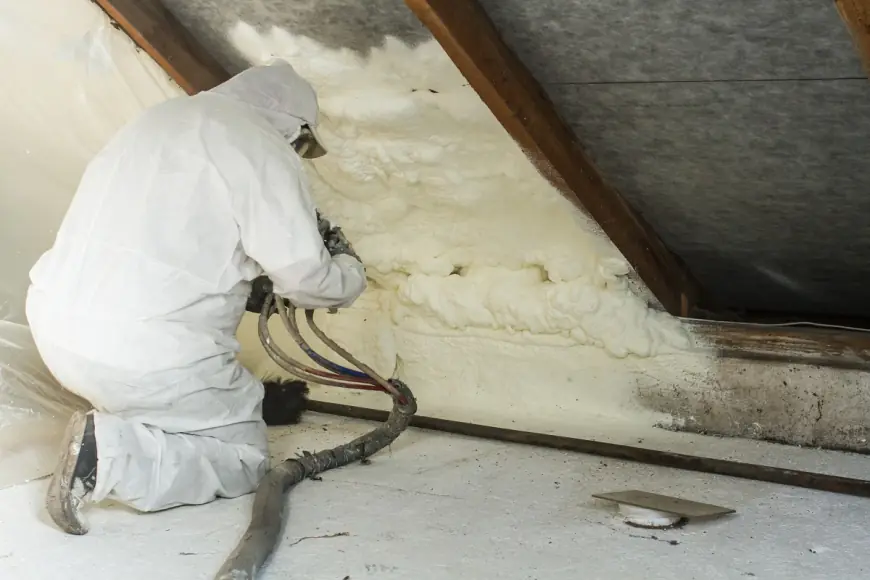Advanced Techniques in Spray Foam Repair for Restoring Thermal Efficiency

Spray foam insulation is widely used in both residential and commercial buildings for its ability to provide a high R-value, control air leakage, and create long-term thermal stability. Over time, however, damage, improper installation, or environmental factors can reduce its performance. Repairing spray foam correctly is essential for restoring thermal efficiency and maintaining structural integrity. This article explores advanced repair methods, the science behind their effectiveness, and practical applications for property owners and contractor.
Understanding Why Spray Foam Loses Thermal Efficiency
Spray foam may deteriorate or lose performance due to external factors or improper installation. Understanding these causes provides the foundation for identifying the right repair approach.
Common Causes of Spray Foam Degradation
Moisture intrusion, physical damage, and UV exposure can compromise spray foam’s integrity. Moisture can seep into open-cell foam, while direct sunlight degrades unprotected surfaces. Cracks, cuts, or punctures from remodeling or pests further reduce insulation effectiveness.
Signs of Reduced Thermal Efficiency
Energy bills that increase unexpectedly, uneven indoor temperatures, or visible gaps in insulation layers often signal a loss of efficiency. In commercial properties, HVAC systems may cycle more frequently, indicating air leakage issues linked to insulation gaps.
Methods for Repairing Spray Foam Insulation
Advanced spray foam repair services involves more than filling gaps. Different approaches are used depending on the extent of damage and whether the foam is open-cell or closed-cell.
Spot Repairs for Minor Damage
For small holes or cracks, spot repairs can restore performance. This involves cutting out the damaged section and applying new foam directly into the cavity. Precision trimming ensures seamless blending with the surrounding insulation.
Full Section Replacement
When foam damage is extensive, a complete section must be removed and replaced. This process includes carefully cutting out compromised insulation, reapplying fresh foam, and allowing proper curing.
Sealing Around Penetrations
Utility penetrations, such as pipes or wiring, often leave gaps where air can leak. Advanced repair techniques focus on carefully applying foam to seal these voids without obstructing access points.
Choosing Between Open-Cell and Closed-Cell Repairs
Different spray foam types require specific repair methods. Understanding these differences helps property owners and contractors apply the correct technique.
Open-Cell Spray Foam Considerations
Open-cell foam is softer and more flexible but can absorb moisture. Repairs typically involve cutting out wet or damaged areas, drying the cavity, and reapplying foam. Care is taken to avoid trapping moisture inside the wall system.
Closed-Cell Spray Foam Considerations
Closed-cell foam is denser and more rigid, offering higher resistance to moisture and air infiltration. Repairing closed-cell foam often involves more precision trimming and surface preparation to ensure strong adhesion.
Advanced Repair Techniques for Thermal Restoration
Restoring spray foam involves specialized methods that maximize energy efficiency while minimizing disruption.
Thermal Imaging for Damage Detection
Infrared scanning identifies hidden gaps, cold spots, and areas of degraded insulation. This diagnostic step allows precise targeting of repairs rather than unnecessary removal.
Hybrid Repair Systems
Some advanced repairs combine foam with rigid insulation or air-sealing membranes to restore both thermal and vapor control. This is often used in commercial roofing or large-scale retrofits.
Layered Foam Applications
In cases of significant damage, applying multiple thin layers of foam instead of a single thick layer ensures better adhesion and curing, reducing the risk of future cracks.
Long-Term Benefits of Professional Spray Foam Repair
Well-executed spray foam repairs restore energy efficiency and extend insulation life. The benefits go beyond immediate performance improvements.
Improved Energy Savings
Sealed gaps reduce air leakage, lowering heating and cooling demands. Both residential and commercial property owners can experience measurable energy savings.
Enhanced Indoor Comfort
Restored insulation reduces drafts and helps maintain consistent indoor temperatures, improving comfort in occupied spaces.
Structural Protection
Closed-cell foam repairs add rigidity and act as a barrier against moisture, which helps protect framing materials from rot or corrosion.
Conclusion
Spray foam repair is a specialized process that directly impacts a building’s energy efficiency and structural integrity. Techniques such as spot repairs, full section replacement, thermal imaging diagnostics, and hybrid systems provide targeted solutions for restoring performance.
Whether addressing minor cracks in a residential wall or repairing widespread damage in a commercial roof, using the right repair method ensures thermal efficiency is restored and maintained over the long term. Partnering with a trusted spray foam insulation company helps property owners benefit from reduced energy costs, improved comfort, and extended building durability.
FAQs
How do you know if spray foam needs repair?
Uneven temperatures, higher energy bills, or visible cracks in insulation often signal that spray foam needs repair. Infrared thermal imaging can confirm hidden gaps.
Can damaged spray foam be patched, or must it be replaced?
Minor cracks and holes can be patched with new spray foam, but larger sections with moisture damage or extensive deterioration usually require full replacement.
Does repaired spray foam perform as well as a new installation?
When applied correctly, repaired spray foam restores thermal efficiency to the same level as a new installation, provided the surrounding insulation is intact.
What role does moisture play in spray foam repair?
Moisture can compromise insulation performance, especially in open-cell foam. Proper drying and preparation are essential before applying new foam.
How long does a spray foam repair last?
A properly executed repair lasts as long as the original spray foam, typically decades, as long as the insulation remains protected from UV exposure and physical damage.
Reviewer: Michael Carter reviewed this article using insight gained over 12 years in the spray foam business. His feedback focused on helping contractors reach new customers without overcomplicating their message.
What's Your Reaction?
 Like
0
Like
0
 Dislike
0
Dislike
0
 Love
0
Love
0
 Funny
0
Funny
0
 Angry
0
Angry
0
 Sad
0
Sad
0
 Wow
0
Wow
0


















































